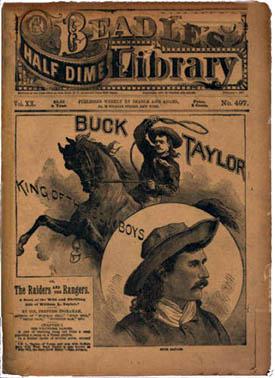
One of the many books, pamphlets, and dime novels featuring Taylor during the 1880s.
Western history buffs easily recognize the name “Buffalo” Bill Cody, the soldier-turned-showman who transformed the American frontier from remote hinterland to popular entertainment. But the star of Buffalo Bill’s Wild West—really America’s first cowboy celebrity—remains relatively obscure, despite a biography nearly as colorful.
Buck Taylor, the handsome, physical cowpoke
during his height as Buffalo Bills star performer.
William Levi Taylor, better known as “Buck,” probably born in Texas in 1857, was orphaned at a young age. Buck taught himself to ride and found work on ranches, eventually making his way to Nebraska. Here, he met Buffalo Bill, who saw something promising in the strapping young Texas and began grooming him for performance.
At 6’ 3”, Buck Taylor towered over most men, with his thick, shoulder-length brown hair and handsome features. A reporter for New York Daily Tribune, seeing Buck standing alongside Buffalo Bill and a show manager in early 1887, desccibed them this way: “Three fine specimens of American manhood stood together yesterday in the cafe of the Hoffman House and attracted a great deal of attention. Their marked physiques alone would have insured notice.” Buck Tayler was no actor. He had a wooden presence on stage and got poor reviews in the 1880s when Buffalo Bill asked him to fill in for him in the title role of a Western-themed play he’d written for himself called The Prairie Waif.
Buffalo Bill Cody, writer, actor, showman,
promoter, entrepreneur, creator of the highly
profitable Wild West Show.
Nevertheless, Buck Taylor delighted crowds in the arena, showing off his riding and roping and even a form of square-dancing on horseback. Buffalo Bill dubbed him “The King of the Cowboys.” He attracted fans, reporters, and, during a European tour, even the British prime minister, who dropped by to say hello during one of the show’s stopovers in London. Prentiss Ingraham, who authored scores of dime novels back then, made Taylor the hero of numerous cowboys-and-Indians yarns with colorful titles such as Buck Taylor, the Saddle King; The Lasso King’s League; The Cowboy Clan; Buck Taylor, the Comanche Captive, and Buck Taylor’s Boys or The Red Riders of the Rio Grande. Ingraham freely invented scenes and dialogues that burnished Taylor’s legend while paying scant attention to historical fact. Buck Taylor left the Wild West show around 1890 and bought a ranch in Wyoming. Later he tried to start his own Western show, but it soon failed. Even after retirement, Buck stayed in the public eye. He spawned an impersonator, a man whose real name was Barry Tatum. Tatum (as Taylor) campaigned for Theodore Roosevelt during Roosevelt’s 1898 campaign to be governor of New York State, and, even more bizarrely, appeared in advertisements for Peruna cough syrup in the Buck Taylor guise. The two men became so confused that when Tatum died in 1900, several newspapers, including The New York Times, believed he actually was Buck Taylor and ran erroneous obituaries. The real Buck Taylor spent his old age as a farmer in Pennsylvania, where he died in 1924 and was famous among the locals for wearing a sombrero. There is yet another Buck Taylor, the actor Walter Clarence aka “Buck” Taylor, best known for his appearances on Gunsmoke
Amy Arden is a Washington, D.C.-based writer and first discovered Buck Taylor at the Library of Congress. She has been following his trail ever since.




